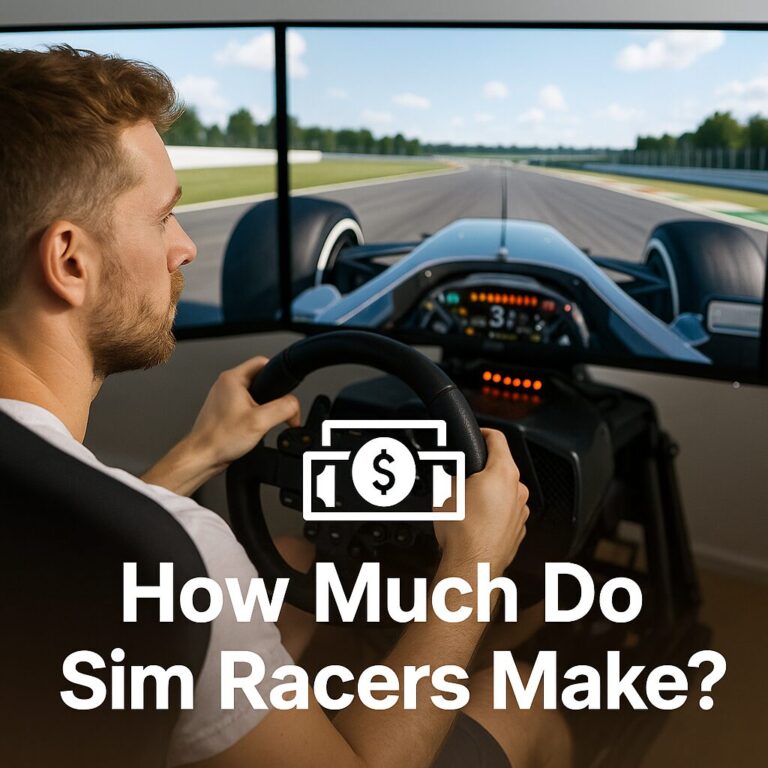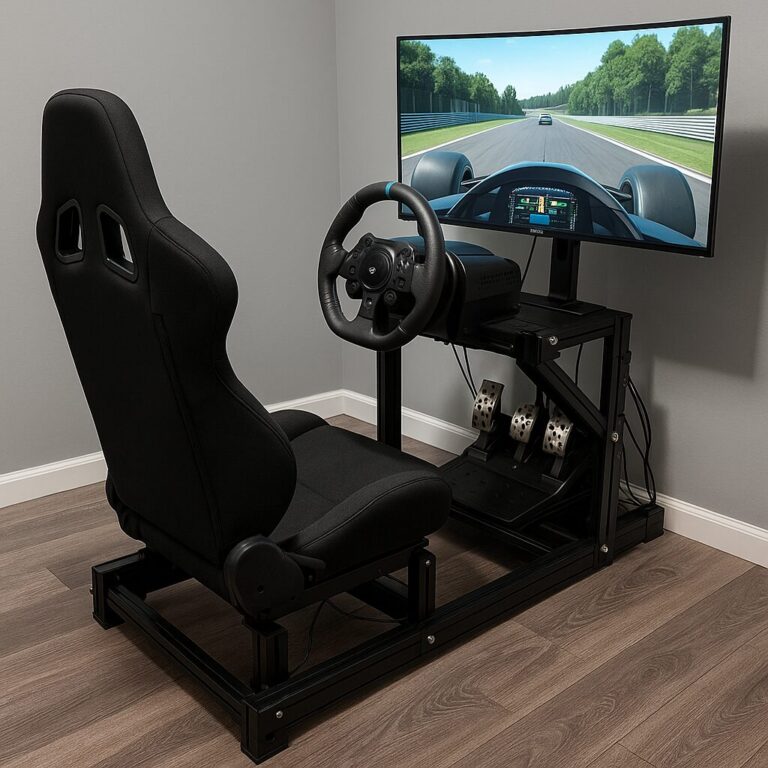Sim Racing Explained: The Realistic World of Virtual Racing
Sim racing (short for “simulation racing”) is a style of virtual motorsport that aims to replicate real-world driving as realistically as possible. Unlike casual arcade racers, sim racing focuses on physics, tire behavior, braking dynamics, car setup, and racecraft. Many drivers use it for fun, training, or even competitive esports.
How Sim Racing Differs From Arcade Racing
- Physics First: Cars react to weight transfer, aero downforce, tire temperatures, and fuel load.
- Authentic Handling: Oversteer, understeer, traction loss, and braking points feel closer to real life.
- Race Procedures: Practice, qualifying, pit stops, flags, and rules mirror real motorsport events.
Core Components of a Sim Racing Setup
1) Hardware
- Wheel Base & Rim: The wheel base generates force feedback; rims vary by racing style (GT, F1, rally).
- Pedals: Load-cell brake pedals enable precise braking pressure for consistent lap times.
- Shifter & Handbrake: Optional for H-pattern gearboxes and rally/drift use.
- Rig & Seat: From wheel stands to full aluminum profile cockpits for stability and ergonomics.
- Display/VR: Single ultrawide, triple monitors, or VR headsets for immersion and depth perception.
- PC/Console: PCs offer the widest title selection and modding; consoles provide quick, consistent setups.
2) Software
- Sim Platforms: Popular titles feature laser-scanned tracks and advanced tire models.
- Cars & Tracks: Official and community content adds new series, circuits, and eras of racing.
- Telemetry & Apps: Tools show lap delta, tire data, and fuel consumption for faster improvements.
The Physics That Make It Feel Real
- Tires: Grip changes with temperature, pressure, wear, and track rubbering.
- Weight Transfer: Braking loads the front tires; acceleration squats the rear; roll affects balance.
- Aerodynamics: High-speed downforce increases cornering ability but adds drag on straights.
- Force Feedback: The wheel communicates road texture, slip angle, and curb strikes to your hands.
Why People Get Into Sim Racing
- Skill Building: Learn race lines, braking markers, and overtaking etiquette safely.
- Affordability vs. Track Days: Practice anytime with no tire or fuel costs.
- Competitive Esports: Ranked lobbies, leagues, endurance events, and team championships.
- Community: Clubs, discords, and leagues for clean racing and coaching.
Getting Started: Step-By-Step
Step 1: Choose Your Platform
Decide between PC or console. PC provides more sims, mods, and accessories; consoles are simpler to start with.
Step 2: Pick a Wheel & Pedals
Entry: gear/belt-drive sets for casual learning. Mid/High: direct-drive wheel bases + load-cell pedals for precision.
Step 3: Select a Sim
Choose a title with cars/tracks you love. Drive the same combo repeatedly to build consistency before expanding.
Step 4: Learn Fundamentals
- Smooth Inputs: Gentle steering and throttle prevent snap oversteer.
- Trail Braking: Ease off the brake while turning to rotate the car.
- Vision: Look through the corner, not at the apex you’re passing.
Step 5: Join Races
Start in unranked lobbies or beginner leagues. Focus on finishing cleanly rather than outright pace.
Car Setup Basics
- Tire Pressures: Target optimal hot pressures for grip and even wear.
- Gears: Adjust final drive for track length and top-speed vs. acceleration trade-offs.
- Suspension: Springs, dampers, and anti-roll bars balance stability vs. rotation.
- Aero: More wing = easier cornering but slower straights; tune for track demands.
Racecraft & Etiquette
- Hold Your Line: Predictability prevents incidents during overtakes.
- Blue/Yellow Flags: Respect faster traffic and hazards.
- Give Space: If alongside at turn-in, leave a car’s width to avoid contact.
- Serve Penalties: Follow lobby or league rules for fair play.
Upgrades & Quality of Life
- Rig Stability: A solid cockpit reduces flex and improves pedal feel.
- Load-Cell Brake: Biggest single upgrade for lap time and consistency.
- Triple Screens or VR: Better depth, mirrors, and spatial awareness.
- Butt-kickers/Motion: Haptics or motion platforms increase immersion and feedback cues.
FAQs About Sim Racing
Is sim racing good practice for real track driving?
Yes—many fundamentals transfer: race lines, braking points, vision, consistency, and strategy. Real cars add risk, heat, and g-forces you won’t feel fully in a sim.
Do I need an expensive setup?
No. You can start with an affordable wheel-and-pedal set. Upgrade gradually as your interest and goals grow.
Can I race with friends online?
Absolutely. Most sims support private lobbies, leagues, voice chat, and scheduled events for clean competition.
What’s the fastest way to improve?
Pick one car and track, practice braking markers, record telemetry or replays, compare with quicker drivers, and focus on clean laps before absolute speed.
Bottom Line
Sim racing blends realistic physics, precise hardware, and competitive online racing into a deeply rewarding hobby. Start simple, practice fundamentals, and enjoy the craft—lap after lap.

Hi, I’m Peter Edwards, a lifelong sim racing enthusiast, tech tinkerer, and automotive geek with a passion for making virtual racing feel as real as possible. I’ve spent years testing steering wheels, pedals, and full cockpit rigs—from entry-level gear to pro-grade setups—to help others build immersive, affordable racing experiences at home.
When I’m not tightening bolts on my rig or tuning force feedback curves, you’ll find me comparing telemetry data, exploring new racing titles, or helping fellow racers fine-tune their setups. My goal is to share honest, experience-based insights that help every driver—from casual weekend racers to aspiring eSports pros—get faster, smoother, and more connected to the track.
I write for SimRacingEnthusiast.com, where I share deep-dive reviews, setup guides, and honest opinions on the latest in the sim racing world.



